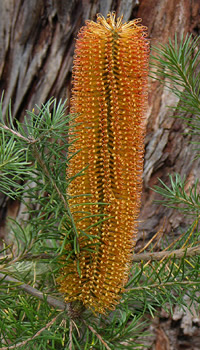Horticulture - Propagation by cuttings
Vegetative propagation - either by cuttings, division or grafting - is used to maintain genetically identical material (i.e. clones). Cuttings are the most common method used in the Gardens. Tissue culture is another means of clonal propagation, not practised in the Gardens.
Cuttings around 100 mm long are taken and most of the leaves removed. The cuttings are dipped in a liquid rooting hormone and placed in punnets filled with a sterilised cutting media. The Gardens' nursery does not drench cuttings with a bleaching solution to disinfest (clean) the cuttings, nor do they apply any fungicides. The key to successful propagation is to practise good hygiene in the nursery and use quality media that has good water holding capacity, yet has high air content (high air filled porosity). Quality media provides the best conditions for root growth and the discouragement of fungi.
Cuttings grow in the Gardens' propagation nursery in poly-tunnels that have heated in-slab concrete bench tops to promote root growth and hygiene. The concrete benches allow water to drain away from the pots and the bench tops are easily cleaned and sterilised.
In the propagation houses, relative humidity is maintained at around 70% with the use of misters. Direct sunlight is filtered with shade-cloth. The high humidity minimises the loss of water from leaves, which helps roots remain moist.
When sufficient roots have formed, usually after four to six weeks, nursery staff transfer the cuttings to pots. There is a choice of pot size, and as plants grow, they are re-potted into larger pots. A measured amount of controlled release fertiliser is added to each pot. The pots are reused - cleaned with water and detergent, and sterilised with steam.
The plants are grown in the production poly-tunnel at the nursery in readiness for the twice yearly plant out. There is no humidification control in the production area of the nursery. Prior to the plant out, plants are hardened off under cover outside the nursery for a few weeks.
All propagation trials and information is stored in the IBIS database.
Plants in the ground at the Gardens or in permanent pots at the nursery provide the stock material for the cuttings. When new plants of a particular clone are required, the nursery staff take cuttings from these plants. Priority is given to threatened species and clones with only a few plants left in the collection.
![Director of National Parks [logo]](../../../images/dnp_90px.gif)






